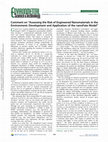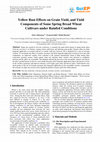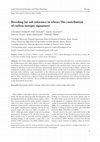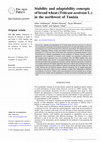Papers by sebei abdennour
International Journal of Agriculture and Biology, 2013

Environmental science & technology, 2018
Comment on "Assessing the Risk of Engineered Nanomaterials in the Environment: Development and Ap... more Comment on "Assessing the Risk of Engineered Nanomaterials in the Environment: Development and Application of the nanoFate Model" G arner et al. 1 recently published on modeling the fate and transport (F&T) of engineered nanomaterials (ENMs). They introduce a compartmental multimedia model (nano-Fate) and claimed improvements, relative to previously reported multimedia models, with respect to treatment of intermedia transport processes, nanomaterial properties, and system dynamics. This communication intends to (a) correct improper perception introduced, perhaps inadvertently, by general statements of Garner et al. 1 regarding alleged deficiencies in previous models, and (b) identify critical nanoFate deficiencies regarding the treatment of intermedia transport of nanoparticles. Previous F&T models were classified by Garner et al. (i.e., cited as references 10−12, 37, 46−50) as "...steady-state multimedia box models, spatial river/watershed models, and materials f low analysis (MFA) models." 1 Although the above classification is useful, one should note that the MendNano model (cited as reference 47 in Garner et al. 1) is in fact a dynamic (i.e., unsteady state) model for simulating the multimedia distribution of ENMs considering the temporal variability of meteorological conditions and source release rates, and the long-term compartmental accumulation of ENMs (e.g., in soil and sediment, Figure 5). 2 MendNano's formulation 2 and its web-based implementation 3 document temporally varying input parameters and examples of simulation results of a dynamic multimedia model that accounts for the particle size distribution and dissolution in water as also noted in a recent review. 4 In reference to previous studies, Garner et al. 1 state that "In all instances, the prediction is based on a f ramework developed for organic chemicals that relies on chemical characteristics and processes that are not applicable to ENMs.(10−12,37,46−50)". The above overgeneralization overlooks the fact that a number of their cited studies (references 37, 47, 48, 50) do incorporate ENMs' specific properties and processes. 4 The statements that "Most existing ENM FT models (cited as references 15,37,47,51−56) make limited use of material-specif ic descriptors" and that "They are also limited with regard to the properties, transport, and transformations they include and the spatial scale and environmental compartments they consider", 1 although may seem reasonable, are overgeneralizations. For example, MendNano and RedNano 2,3 consider in detail: (i) ENMs' intermedia transport (e.g., dry deposition, rain scavenging, sedimentation, and dissolution) as governed by their particle size distribution, 5 (ii) ENMs' association with ambient particles, (iii) temporally varying meteorological conditions (e.g., rain, wind speed, temperature), and (iv) media characteristics (e.g., dimensions, soil type, vegetation coverage, flow rates, and more). Garner et al. assess that "...the [MendNano] model is limited with regards to mass transfer processes between soil and water, use simplif ied ENM transformation processes, excludes climate variability...Only one water chemistry (i.e., fresh water or marine) and one soil type can be modeled." 1 Contrary to the above

World Journal of Agricultural Research, 2018
Stripe rust caused by Puccinia striiformis, is currently the major foliar disease of spring bread... more Stripe rust caused by Puccinia striiformis, is currently the major foliar disease of spring bread wheat (Triticum aestivum L.) in Tunisia, causing serious yield losses and affecting grain quality. Farmers often use foliar fungicide application or resistant cultivars to counter yield loss, however, this is hampered by a lack of resistant varieties. To investigate the effects of genetic resistance and foliar fungicide application on disease level and yield components, six improved varieties were evaluated at the regional experimental station in Beja during three consecutive growing seasons. Under natural stripe rust infection, three varieties were detected as completely resistant and the others are susceptible. The pathogen affected the leaf area in the susceptible varieties and reduces the above ground biomass at harvest, seed weight and grain yield. Fungicide application reduces the disease severity on the sensitive genotypes and improves biomass, seed weight, grain yield, and harvest index. Yield benefits were much greater in the use of resistant genotypes than fungicide application on the susceptible varieties; consequently the resistance to stripe rust can have more significant benefits to farmer and to the wheat industry.

Czech Journal of Genetics and Plant Breeding
Use of low-quality water for supplemental irrigation is expected to become soon a common practice... more Use of low-quality water for supplemental irrigation is expected to become soon a common practice in the Mediterranean area, where durum wheat is the main cultivated cereal. Breeding for salt stress tolerance may contribute to the improvement of wheat resilience to irrigation with brackish water. Various traits can be considered as indicators of salt stress tolerance, which include agronomical and physiological criteria. However, the complexity of salinity tolerance mechanisms, the G × E interaction and the lack of correlation between controlled and open field conditions causes uncertainty in the selection process. The present review highlights the main advantages and limitations of different agronomical and physiological traits used in screening for salt stress tolerance in wheat. Special focus is given to carbon and nitrogen isotope discrimination, that remains a bottleneck in breeding for salt stress tolerance. The use of different statistical tools to analyse data related to sal...

Biologia Futura
Introduction: Stability and adaptability of 25 bread wheat (Triticum aestivum L.) cultivars were ... more Introduction: Stability and adaptability of 25 bread wheat (Triticum aestivum L.) cultivars were evaluated for genotype × environment interaction (G × E) and yield stability across two environments over 2 years (2014 and 2015). Materials and methods: Five improved varieties (Haidra, Salammbô, Tahent, Utique, and Vagua) released in Tunisia and 20 introduced genotypes (V1-V20) have been tested under two contrasted environments during 2 years characterized by different precipitations in the northwest of Tunisia. Several statistical approaches were conducted to evaluate yield stability: (a) regression coefficient (b i), (b) deviation from regression (S di), (c) ecovalence (W i), (d) Hühn stability (S li), and (e) AMMI stability value. Results: A standard multifactor analysis of variance test showed that the main effects due to genotypes, locations, and the interaction (genotype × locations) were highly significant. The highly significant interactions indicate that genotypes need to be tested during several years and at different locations for selecting the most stable one. The results showed that all statistical analyses allowed classifying the 25 studied genotypes according to their grain yield level (low, medium, or high), their adaptability to different environments. Conclusion: Tahent variety was confirmed to be most valuable due to its high production level, stability and its adaptability to variable environments including unfavorable ones.











Uploads
Papers by sebei abdennour